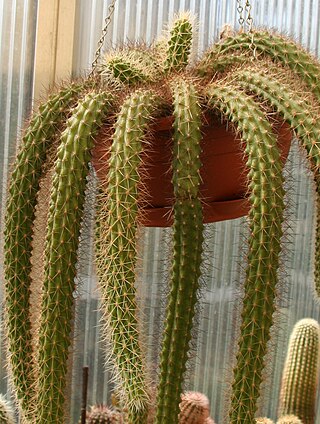
The Chihuahuan Desert is a desert ecoregion designation covering parts of northern Mexico and the southwestern United States. It occupies much of far West Texas, the middle to lower Rio Grande Valley and the lower Pecos Valley in New Mexico, and a portion of southeastern Arizona, as well as the central and northern portions of the Mexican Plateau. It is bordered on the west by the Sonoran Desert, the Colorado Plateau, and the extensive Sierra Madre Occidental range, along with northwestern lowlands of the Sierra Madre Oriental range. Its largest, continual expanse is located in Mexico, covering a large portion of the state of Chihuahua, along with portions of Coahuila, north-eastern Durango, the extreme northern part of Zacatecas, and small western portions of Nuevo León. With an area of about 501,896 km2 (193,783 sq mi), it is the largest desert in North America. The desert is fairly young, existing for only 8000 years.

Echinocereus is a genus of ribbed, usually small to medium-sized, cylindrical shaped cacti, comprising about 70 species native to the southern United States and Mexico in very sunny, rocky places. Usually the flowers are large and the fruit edible.

The term ceroid cactus is used to describe any of the species of cacti with very elongated bodies, including columnar growth cacti and epiphytic cacti. The name is from the Latin cēreus, wax taper, referring to the stiff, upright form of the columnar species. Some species of ceroid cacti were known as torch cactus or torch-thistle, supposedly due to their use as torches by Native Americans in the past.

Morangaya is a monotypic genus of ribbed, usually small to medium-sized, cylindrical shaped cacti, that is native to north western Mexico. The only species is Morangaya pensilis. It is found in the mountains and rocky hills.
The Botanical Research Institute of Texas (BRIT) is a botanical research institute located in Fort Worth, Texas, United States. It was established in 1987 for the herbarium and botanical library collections of Lloyd H. Shinners from Southern Methodist University but has subsequently expanded substantially. BRIT focuses on plant taxonomy, conservation and knowledge sharing for both scientists and the general public

The Fort Worth Botanic Garden is a botanical garden located at 3220 Botanic Garden Boulevard, Fort Worth, Texas. The garden was established in 1934 and is the oldest major botanic garden in Texas. It is located in the heart of the cultural district.

Echinocereus reichenbachii is a perennial plant and shrub in the cactus family. The species is native to the Chihuahuan Desert and parts of northern Mexico and the southern United States, where they grow at elevations up to 1,500 meters (4,900 ft). This cactus earned the Royal Horticultural Society's Award of Garden Merit.

Echinocereus chisoensis is a rare North American species of cactus known by the common name Chisos Mountain hedgehog cactus, native to the Chihuahuan Desert of northern Mexico and the south-central United States.

Echinocereus viridiflorus is a species of cactus known by the common names nylon hedgehog cactus, green pitaya, and small-flowered hedgehog cactus. It is native to the central and south-central United States and northern Mexico, where it can be found in varied habitat types, including desert scrub, woodlands, dry grasslands, and short-grass prairie.

Echinocereus dasyacanthus is a member of the cactus family, Cactaceae. It is one of about 2000 total species belonging to this family. The cactus is commonly known as Texas rainbow cactus because of the subtle rings or bands of contrasting colors along the stem of the plant. Not all Texas rainbow cacti have the "rainbow" coloration on their stems. Another common name is spiny hedgehog cactus.

Echinocereus stramineus is a species of cactus, wih stramineus meaning made of straw. There are various common names such as strawberry cactus, porcupine hedgehog cactus, straw-color hedgehog, and pitaya. The straw-colored spines distinguishes this particular plant from other Echinocereus. The aged spines may turn white in color and are very fragile.

Echinocereus poselgeri, also known as the dahlia cactus, is a species of Echinocereus. It is native to Coahuila and southern Texas.

Echinocereus pentalophus, with the common name ladyfinger cactus, is a species of Echinocereus cactus, in the tribe Echinocereeae Tribe. It is native to North America.

Echinocereus berlandieri is a species of hedgehog cactus. Its range includes most of South Texas, and is commonly found along the Nueces River and the lower Rio Grande.

Echinocereus pectinatus is a species of hedgehog cactus. It was first described by Engelmann in 1848. It is found in the south-western US and northern Mexico.
Bertha Marion Lahman (1872–1954) was an American botanist specializing in cacti of Oklahoma.
Lloyd Herbert Shinners was a Canadian-American botanist and professor who had expertise in the flora of Texas and Wisconsin.
John Cameron Semple is a botanist, cytotaxonomist, professor emeritus, and adjunct professor at the University of Waterloo in Ontario, Canada. He was born in Boston and earned a degree of Bachelor of Science in 1969 from Tufts University, followed in 1971 and 1972 by Master of Arts and Doctor of Philosophy degrees from Washington University in St. Louis. Semple is known for his work with members of the tribe Astereae, particularly goldenrods, American asters, and goldenasters, and he maintains the University of Waterloo Astereae Lab website. Semple's wife is Brenda, and in 2013, he named a newly discovered goldenrod species Solidago brendiae in honor of her.

Echinocereus scheeri is a species of hedgehog cactus in the family Cactaceae, native to northern Mexico. With its dramatic offsets, it has gained the Royal Horticultural Society's Award of Garden Merit.

Echinocereus websterianus, commonly known as the San Pedro Nolasco hedgehog cactus or Webster's hedgehog cactus, is a species of cactus. It is named after American philanthropist Gertrude Webster, who cofounded the Desert Botanical Garden in Phoenix, Arizona.
















